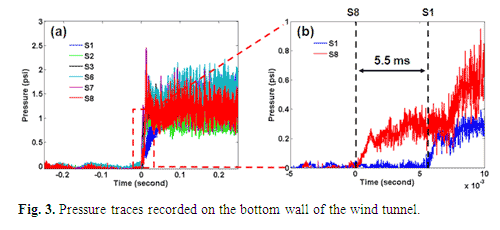| Tunnel unstart induced by air jet injection is clearly reflected in the pressure traces measured on the bottom surface of the wind tunnel. Figure 3 (a) documents the sudden pressure rise at the various locations on the wall following the jet injection through the nozzle located between S4 and S5. The time reference (t = 0 sec) in this figure corresponds to when the pressure first rises at the sensor located at S8 (i.e., the farthest downstream region characterized). The pressure at S8 starts to rise abruptly at approximately 10 ms after the jet injection trigger signal opens the solenoid valve. Absolute pressure offsets are subtracted from the traces to illustrate relative differences between the pressure recorded before and after the jet injection. The pressure traces recorded at the locations nearest to the jet nozzle (S4 and S5, not shown) fluctuate significantly, due to flow instabilities in the near field of the jet. It is noteworthy that the first pressure increase is recorded at S8 and this high pressure region then expands towards the upstream region of the tunnel, presumably along the subsonic boundary layer, in succession through to the location at S1 (an expanded scale showing only the S8 and S1 traces is shown in Fig. 3 (b)). This ordering in the rise in pressure confirms that choking originates downstream of the jet injection point, triggering tunnel unstart, i.e., a transition to a subsonic flow regime. The propagation of this high pressure region from S8 to S1 (over 12 cm distance) takes approximately 5.5 ms (see Fig. 3 (b)) indicating that that this pressure wave propagates at a speed of approximately 22 m/s. For comparison the freestream speed is approximately 750 m/s. |

